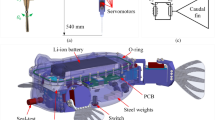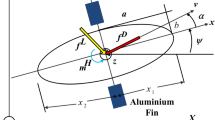Abstract
Purpose
Fishes like Mackerel, salmon and trout have been a great inspiration for effective underwater propulsion. Their propulsion mechanism involves flap** the posterior body members. Fish actively modify the stiffness of these members to meet various swimming requirements.
Methods
In this study, two posterior body parts of a fish, namely the peduncle and the caudal fin, are analysed for biomimetic propulsion. These members are modelled as Euler–Bernoulli beams and appropriate stiffeners are introduced at their joints. The surrounding fluid domain is modelled using potential flow theory. The fluid–structure interaction results in an added-mass effect. The mean propulsive thrust depends on the tip velocity of the flap** structure, and hence, it could be maximised by increasing the peak response bandwidth.
Results
This work presents the sensitive range of the stiffness parameters, such as the stiffness of the members and the coupling stiffeners, which are essential for thrust augmentation. The resonance of the system is discussed for various peduncle–caudal dimensions observed in salmon fish.
Conclusion
The study presents the theoretical modelling of peduncle–fin-inspired coupled structures for underwater propulsion. The results highlight the potential for improving thrust by appropriately adjusting the structural stiffness parameters.






Similar content being viewed by others
Data availability
Data is available on request from the authors.
References
Sfakiotakis M, Lane DM, Davies JBC (1999) Review of fish swimming modes for aquatic locomotion. IEEE J Ocean Eng 24(2):237–252. https://doi.org/10.1109/48.757275
Lighthill MJ (1960) Note on the swimming of slender fish. J Fluid Mech 9(2):305–317. https://doi.org/10.1017/S0022112060001110
Yang M, Wang Y, Liang Y, Wang C (2022) A new approach to system design optimization of underwater gliders. IEEE/ASME Trans Mechatron 27(5):3494–3505. https://doi.org/10.1109/TMECH.2022.3143125
Shuai Huang MH, Lyu Y (2021) Seismic performance analysis of a wind turbine with a monopile foundation affected by sea ice based on a simple numerical method. Eng Appl Comput Fluid Mech 15(1):1113–1133. https://doi.org/10.1080/19942060.2021.1939790
Dai Z, **e J, Jiang M (2023) A coupled peridynamics–smoothed particle hydrodynamics model for fracture analysis of fluid–structure interactions. Ocean Eng 279:114582. https://doi.org/10.1016/j.oceaneng.2023.114582
Xu J, Liu J, Zhang Z, Wu X (2023) Spatial-temporal transformation for primary and secondary instabilities in weakly non-parallel shear flows. J Fluid Mech 959:21. https://doi.org/10.1017/jfm.2023.67
Fu Y, Price WG (1987) Interactions between a partially or totally immersed vibrating cantilever plate and the surrounding fluid. J Sound Vib 118(3):495–513. https://doi.org/10.1016/0022-460X(87)90366-X
Cheung YK, Zhou D (2000) Coupled vibratory characteristics of a rectangular container bottom plate. J Fluids Struct 14(3):339–357. https://doi.org/10.1006/jfls.1999.0272
Bhamra NS, Vijayan K, Nagarajan V (2022) Bio-inspired aquatic propulsion using piezoelectric effect. J Intell Mater Syst Struct 33(9):1161–1169. https://doi.org/10.1177/1045389x211048230
Erturk A, Delporte G (2011) Underwater thrust and power generation using flexible piezoelectric composites: an experimental investigation toward self-powered swimmer-sensor platforms. Smart Mater Struct 20(12):11. https://doi.org/10.1088/0964-1726/20/12/125013
Matthews DG, Zhu R, Wang J, Dong H, Bart-Smith H, Lauder G (2022) Role of the caudal peduncle in a fish-inspired robotic model: how changing stiffness and angle of attack affects swimming performance. Bioinspiration Biomim 17(6):066017. https://doi.org/10.1088/1748-3190/ac9879
Zou Q, Zhou C, Lu B, Liao X, Zhang Z (2022) Tail-stiffness optimization for a flexible robotic fish. Bioinspiration Biomim 17(6):066003. https://doi.org/10.1088/1748-3190/ac84b6
Ghose J, Gokarn R (2004) Basic ship propulsion. Allied Publishers, New Delhi
Cen L, Erturk A (2013) Bio-inspired aquatic robotics by untethered piezohydroelastic actuation. Bioinspiration Biomim 8(1):13. https://doi.org/10.1088/1748-3182/8/1/016006
Shahab S, Erturk A (2016) Electrohydroelastic Euler–Bernoulli–Morison model for underwater resonant actuation of macro-fiber composite piezoelectric cantilevers. Smart Mater Struct 25(10):15. https://doi.org/10.1088/0964-1726/25/10/105007
Jayne BC, Lauder GV (1995) Speed effects on midline kinematics during steady undulatory swimming of largemouth bass, Micropterus salmoides. J Exp Biol 198(2):585–602. https://doi.org/10.1242/jeb.198.2.585
Wainwright DK, Lauder GV (2020) Tunas as a high-performance fish platform for inspiring the next generation of autonomous underwater vehicles. Bioinspiration Biomim 15:1. https://doi.org/10.1088/1748-3190/ab75f7
The MathWorks Inc. MATLAB Version: 9.13.0 (R2022b). https://www.mathworks.com
Vijayan K, Woodhouse J (2013) Shock transmission in a coupled beam system. J Sound Vib 332(16):3681–3695. https://doi.org/10.1016/j.jsv.2013.02.024
Wing BL, Masuda MM, Guthrie III CM, Helle JH (1998) Some size relationships and genetic variability of Atlantic salmon (Salmo salar) escapees captured in Alaska fisheries, 1990–95. U.S. Department of Commerce, NOAA Technical Memorandum NMFS-AFSC-96, 32 p
Brosse S, Charpin N, Su G, Toussaint A, Herrera-R GA, Tedesco PA, Villéger S (2021) Fishmorph: a global database on morphological traits of freshwater fishes. Glob Ecol Biogeogr 30(12):2330–2336. https://doi.org/10.1111/geb.13395
Funding
Authors gratefully acknowledge the support and funding received for the work from the NRB, India, under project no. NRB/4003/PG/1611/D(R &D), NRB/456/19-20.
Author information
Authors and Affiliations
Corresponding author
Ethics declarations
Conflict of interest
The authors declared no potential conflicts of interest with respect to the research, authorship, and/or publication of this article.
Additional information
Publisher's Note
Springer Nature remains neutral with regard to jurisdictional claims in published maps and institutional affiliations.
Rights and permissions
Springer Nature or its licensor (e.g. a society or other partner) holds exclusive rights to this article under a publishing agreement with the author(s) or other rightsholder(s); author self-archiving of the accepted manuscript version of this article is solely governed by the terms of such publishing agreement and applicable law.
About this article
Cite this article
Bhamra, N.S., Vijayan, K. & Nagarajan, V. Underwater Biomimetic Propulsion Using Coupled Structures. J. Vib. Eng. Technol. (2023). https://doi.org/10.1007/s42417-023-01212-z
Received:
Revised:
Accepted:
Published:
DOI: https://doi.org/10.1007/s42417-023-01212-z




